百卷大书 读通浙江
文/沈听雨
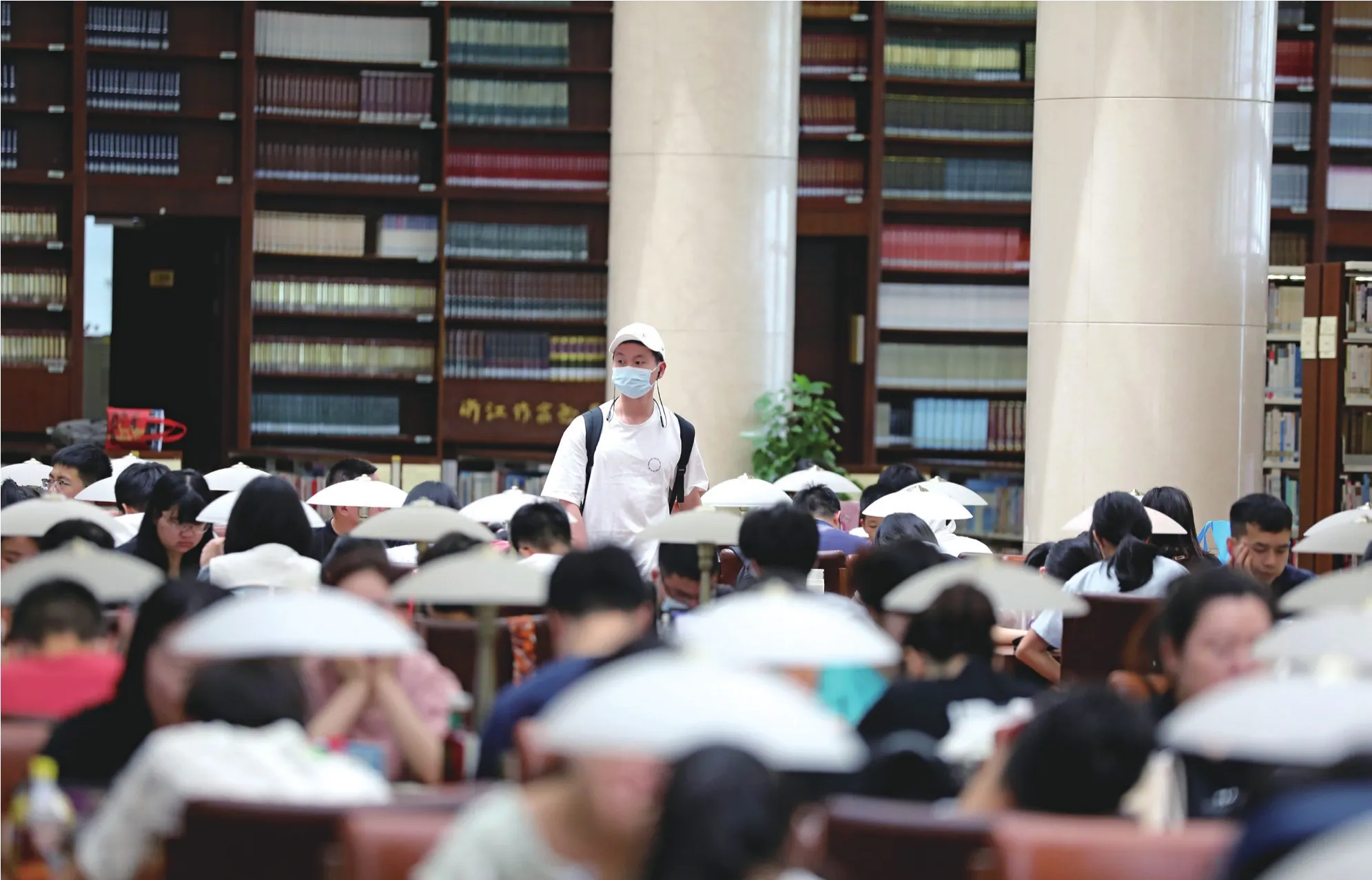
全省各地图书馆已陆续收藏《浙江通志》,图为杭州图书馆阅览室现场。魏志阳 李镜媛/摄The Zhejiang General Chronicle has been collected by libraries in Zhejiang province. The picture shows readers at the Hangzhou Library. Photo by Wei Zhiyang and Li Jingyuan.
先秦以来,国有史,郡县有志,家族有谱。编史修志,是世代相沿的文化传统,也是华夏文明的文化基因。
“一方之志,始于越绝。”2000多年前,中国地方志诞生于浙江绍兴,《越绝书》成为“方志之祖”;南宋时,“临安三志”和“会稽二志”是中国传统方志的定型之作;至清代,绍兴人章学诚被称为中国方志学奠基人。因此,浙江素有“方志之乡”的美誉。
赓续绵延千年的修志传统,在今天得到进一步继承发扬。不久前,《浙江通志》首发式隆重举行。它于2011年启动编纂,2022年6月全面完成出版任务。历时11年,共113卷(其中公开出版的111卷)、131册,计1.31亿字,是自清雍正《浙江通志》编竣后,近300年来第一部完整的省志,全面展现了浙江自然、政治、经济、文化和社会等各方面筚路蓝缕的发展历程,堪称是一部系统介绍浙江的百科全书。
志书如何得以修成?其中怎样体现浙江发展脉络和特色?记者开卷细览,并采访了部分志书的编纂团队成员。交流中,历史的风云、当下的现实、未来的前景缓缓铺陈开来—
每一卷都起码打磨五年
方志学奠基人章学诚认为,“方志乃一方之全史”。地方志,是一个地方历史记录和文化传承的重要载体。
志书的定位是“资料性文献”,因此要比其他研究和文献形式更“全面、客观、系统”。而通志,一般是记述特定行政区域贯通古今的历史发展过程,时间上的跨度更长。此次《浙江通志》的记录时限,就是从不同事物的历史发端开始直到2010年为止。
“编纂志书讲究‘横排竖写’,即横不缺项,纵不断线。”《浙江通志》总编俞文华告诉笔者,比如编写《教育志》,首先要把教育按照幼儿教育、基础教育、高等教育、职业教育、成人教育、特殊教育等大类进行划分;再比如写基础教育,要按小学、中学等门类进行细分,然后再从其中各项入手,按照时间线把它们的历史、现状都记述清楚。
这并不是记流水账,而是依时间顺序,客观真实、全面系统地收集、整理某一时间段的重要政策、关键事件、重点人物等,根据地方志的记述要求来加以呈现。
编纂志书不能添油加醋,也无须过多修饰,但需要相关编纂人员仔细核实资料,确保入志的事件、人物等准确无误,交代清楚。
“修志虽然避免议论性的表达,但并不意味着没有观点。其实,在对入志资料挑选时,观点就已经融入其中。”《浙江通志》总编室主任颜越虎说,《浙江通志》在选择门类和事件时,会考虑它们是否能体现浙江发展的历史、成就和地方特色、时代特征,以此为依据进行篇目设置、志稿编写。
志书的编纂,讲究严谨与规范,这条路漫长且艰辛。
《浙江通志·方言志》是首批出版的志书之一。杭州师范大学人文学院徐越教授是该卷的主编,她和浙江方言打交道已有30多年,但在编纂《方言志》时,仍深感其中的难度和挑战。
“因为是修志,所以全省每个县的方言都要有所覆盖。”徐越说,浙江的方言分布情况较为复杂,例如我们知道杭州话因为宋室南迁等原因,只分布在杭州老城区,但梅家坞一带也说杭州话。这些年来,汉语方言发生巨大变化,浙江老派方言特点流失日趋严重,现有资料已难以完整反映更早时期浙江省方言全貌。加上多数方言并没有书面记载,要通过田野调查,从各地居民特别是老人的口中去寻找、记录。
调查过程中,不仅要找到合适的“发音人”,最理想的是三代以上的当地人,不能有长期外出读书或工作的经历,反应要快,记性也要好。同时,还要不断启发“发音人”,不厌其烦询问相关信息,并一字一句地用国际音标记录下来。有时,还需要“发音人”配合体会舌头的位置,感受某个音的发音部位和发音方法,从中抓住当地方言里最主要的特征,进行归纳和记录。
同样因缺乏书面记载而需要进行大量实地调查的还有民俗。浙江大学哲学学院教授、《浙江通志·民俗志》副主编何善蒙表示,在浙江历史上,把民俗作为单独门类进行修志,这是第一次。浙江民俗资源丰富,但民俗研究相对而言却比较薄弱,整体较为散乱。
人们常说“十里不同风,百里不同俗”,可见风俗的异同是一切行政区域皆可能出现的。但地域历史文化发展中最生动、接地气的传统往往也正是民俗。
“编纂时,我们尝试着转换视角,去寻找民俗在老百姓日常生活中的表现力。”何善蒙说,自2012年浙江省民俗文化促进会承编以来,经过资料收集、实地调研以及资料长编整理、集中编纂等,直到2020年6月,《民俗志》才正式出版面世。
细数《浙江通志》每一卷,编纂团队都历经了至少5年时间才打磨完成。白纸黑字的背后,是学者们对浙江历史文化的守望和耕耘。他们紧揣着情怀与责任,奔波在之江大地,徜徉于史海文山,笔耕日月星辰,终成皇皇巨构。
钱江潮天目山茶叶都编纂入志
浙江历史悠久、源远流长。在这片沃土上,文物遗迹数不胜数,文化精品琳琅满目。记者注意到,此次《浙江通志》的113卷中,还特别设置了《钱塘江专志》《雁荡山专志》《天目山专志》《海塘专志》《运河专志》《蚕桑丝绸专志》《茶叶专志》《越文化专志》等14卷特色专志,以此来提炼、彰显浙江独特的自然风貌和历史文脉。
“浙江之潮,天下之伟观也。”钱塘江,是浙江的母亲河,也是无数浙江人的地方情结之所在。
《钱塘江专志》是《浙江通志》第九十八卷,在以某个具体自然地物作为记述对象的专志中,位列第一卷。该专志主编徐有成说:“20世纪末,浙江曾从水利的角度编过《钱塘江志》,但这次新编却不仅限于此,还力求从人文历史中凸显钱塘江的地方特色。”
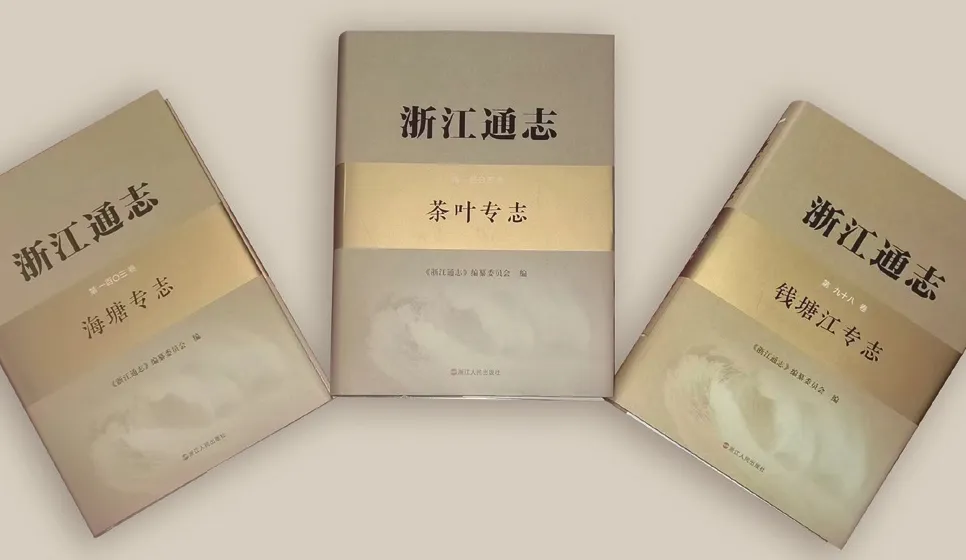
《浙江通志·海塘专志》《浙江通志·茶叶专志》《浙江通志·钱塘江专志》。The three volumes on Zhejiang’s seawalls, tea and the Qiantang River in the Zhejiang General Chronicle.
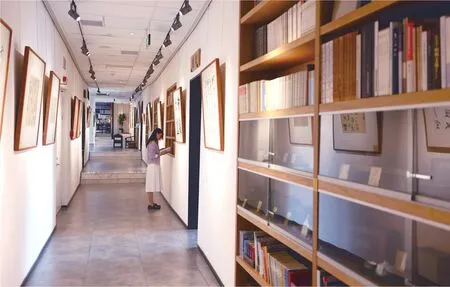
杭州图书馆宋韵分馆。王建龙 李镜媛/摄The Song Dynasty Culture Branch of the Hangzhou Library. Photo by Wang Jianlong and Li Jingyuan.
于是,《钱塘江专志》为钱江潮和海塘开辟专章,并进行了浓墨重彩的介绍。
钱江潮,以汹涌澎湃、气势磅礴之景闻名于世,被誉“天下奇观”。大潮拍岸惊涛,曾引无数文人墨客留下诗篇—“鲲鹏水击三千里,组练长驱十万夫”“海阔天空浪若雷,钱塘潮涌自天来”……而观潮的习俗则始于汉魏,盛于唐宋,流传至今。钱江潮,不仅是水文奇观,也成为一种文化意象和精神象征。
笔者发现,在《钱江潮》一章中,编纂团队不仅系统整理了关于“钱江潮”的各类水文数据,介绍在现代水文科学视野下钱江潮的生成机理,还梳理了观潮作为浙江特有的社会、文化现象,古往今来人们对于“钱江潮”的观察与研究,以及针对观潮行为的社会管理。
在徐有成看来,作为《浙江通志》的一部分,《钱塘江专志》不能仅从自然区域的角度去编纂,还要回答钱塘江对于浙江而言意味着什么这一问题。如此,就需要从更大的视野来看钱塘江。
《茶叶专志》主编阮浩耕也认同这一观点。浙江的茶叶种植、饮茶历史历经千年,创造了丰厚的物质文明,孕育了浓厚的精神遗产,造就了享誉中外的茶文化。此次《茶叶专志》更是用大量篇幅,记述了浙江茶文化,强化了茶叶的文化特性。
南宋吴自牧所著的《梦粱录》中有“盖人家每日不可阙者,柴米油盐酱醋茶”的描写。也许是江南湿润多雨的气候、清淡的饮食,让浙江人在长久的光阴里逐渐形成饮茶的习俗,由此演变成此地不可割舍的文化脉络。
翻阅《茶叶专志》,该志在篇目设置上专门设有茶文化一章,下设茶以载道、茶事艺文、茶馆文化、茶事礼俗、茶文化胜迹、非物质文化遗产、茶文化对外传播与交流、茶文化社团与活动等八节,是各章中设节最多的一章。
千年以来,茶的滋味延续不断。而从采茶、饮茶、品茶中,一代代爱茶者以各自擅长的艺术形式展现着其中蕴含的情趣。唐代的咏茶诗,宋代的茶画与法书,元代的茶事入戏,明清以散文、小说书写茶情,近现代关于茶的歌舞和影视等,这些都被一一记录在《茶叶专志》中,拓宽了其作为浙江茶叶专志的内涵。
“编纂时,我们还特别增加了现存浙江的古茶树一节,通过在各地调研、搜集资料,明确了目前浙江共有20处古茶树所在地。”阮浩耕说,这是《茶叶专志》编纂的一大成果,这些古茶树不仅是茶叶科研的对象,也是景观资源,更是浙江的文化积淀。
修志为用,让大部头活起来
夏日,走进杭州临安的天目山抗战展示馆,讲解员正在向参观者介绍发生在这里的抗战故事。里面的展陈文稿,来自《浙江通志·天目山专志》。
《天目山专志》是《浙江通志》中第一家通过初审、第一批出版的志书,完整记载了各历史时段天目山在自然、科研、生态保护、旅游开发等方面的变化,已然成为大家了解天目山的首要参考资料之一。今年3月,省地方志办公室印发《关于公布〈浙江通志〉编纂成果转化应用“十佳”典型案例和优秀案例的通知》,《天目山专志》的应用入选“十佳”典型案例。
修志的目的在于用志。如今,《天目山专志》还成为天目山“名山公园”建设的主要参考资料之一,助推天目山“名山公园”高质量建设和生物多样性保护工作。
东晋常璩在《华阳国志》序志中说,地方志有“达道义、章法戒、通古今、表功勋、旌贤能”的作用。地方志编纂,既是因为眷恋一方水土,让所在地的方方面面形成系统性文件被记录,也是为地方发展进一步积聚力量,让后人能以更饱满的精神意气风发地发投入到新时代建设中。
正如《浙江通志·越文化专志》主编潘承玉所说,全面梳理越国历史文化,意在化古为新,激活其中以“胆剑精神”为核心的越文化的不朽生命力,为新时代的文化浙江建设引入丰厚的历史资源。
坚持“修志为用”的理念,推动方志成果转化应用的天地很广阔。
“我们不能让《浙江通志》成为束之高阁的志书。”浙江省人民政府地方志办公室主任郑金月表示,接下来,将进一步拓展用志途径,发挥方志功能,让这项有着两千多年历史的古老事业焕发新机。
比如,依托数字化改革,推动传统方志向数字方志转型,打造一批可听、可视、可读、可体验的方志产品,推进地方志“用起来”“立起来”“活起来”“热起来”;比如,加强各卷资源的开发利用,将其融入宋韵文化、大运河文化、钱塘江文化、诗路文化等研究活动,发挥志书在新时代文化高地建设中的基础作用;比如,利用方志成果,推动浙江故事走向海外;比如,利用方志记载的人物和故事,进行精品文艺创作。
盛世修志,志载盛世。翻阅这一册册装帧精美、典雅厚重的志书,字里行间是时间与空间的激荡、历史与现实的交响。
Zhejiang Province in a Hundred Volumes
By Shen Tingyu
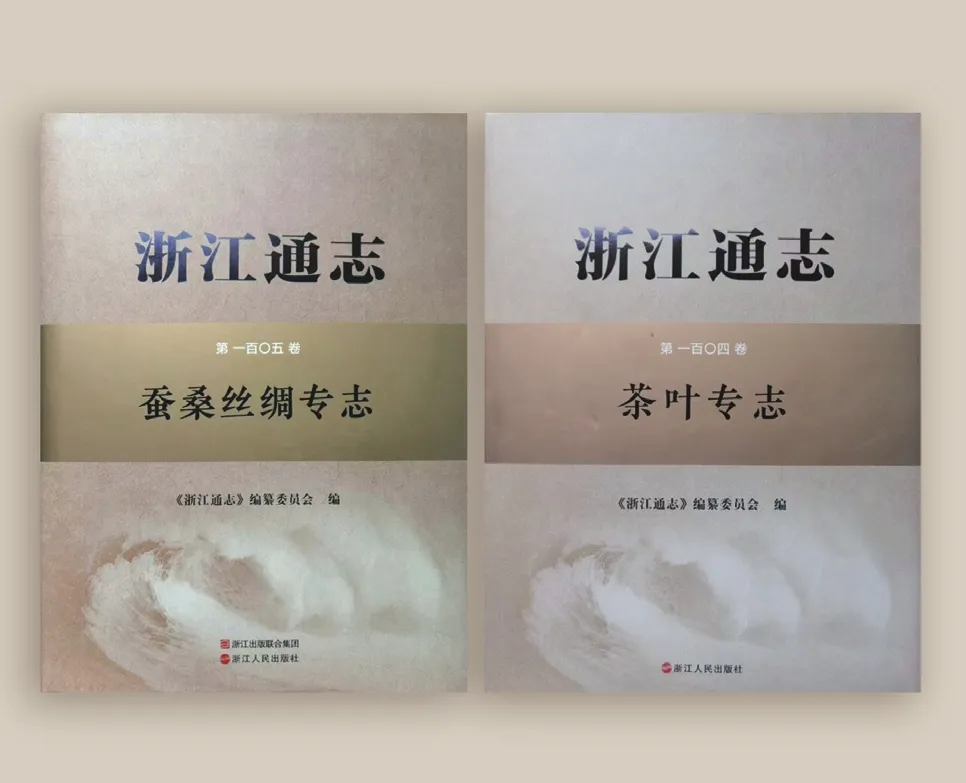
《浙江通志·蚕桑丝绸专志》和《浙江通志·茶叶专志》。The two volumes on sericulture & silk and tea in the Zhejiang General Chronicle.
Since the pre-Qin period, there has been a history for states,local gazetteers or chronicles for prefectures and counties, and a genealogy for families. Compilation of histories and chronicles is a cultural tradition that has been passed down from generation to generation, and it is also the cultural gene of Chinese civilization.Local chronicles began within Zhejiang’s Shaoxing city more than 2,000 years ago, which became the “prototype of local chronicles”. In the Southern Song dynasty (1127-1279),the “Three Chronicles of Lin’an” and “Two Chronicles of Kuaiji”were the pacesetters of traditional Chinese local chronicles. In the Qing dynasty (1616-1911), Zhang Xuecheng (1738-1801) from Shaoxing was known as the founder of Chinese local chronicles.Therefore, Zhejiang is known as the “Hometown of Local Chronicles”.
Not long ago, the launch ceremony ofwas held. It started to be compiled in 2011 until it was fully published in June 2022. In the last 11 years, a collection of 113 volumes in 131 books (including 111 volumes published and distributed openly) were issued, totaling 131 million Chinese characters. The process of Zhejiang’s natural, political, economic,cultural and social development is shown comprehensively, hence an encyclopedia that systematically introduces Zhejiang.
Zhang Xuecheng believed that local chronicles are an important carrier of local historical records and cultural heritage,thus more “comprehensive, objective and systematic” than other forms of research and documentation. The time span that thehas covered is from the historical origins of different things in different areas to the year 2010.
Yu Wenhua, editor-in-chief of,said that in compiling “educational records”, education should be based on major categories of education, including early childhood education, basic education, higher education, vocational education,adult education, special education and others; basic education should be subdivided into categories such as primary school and middle school, and then they are further divided according to the timeline.
The volume on Zhejiang’s dialects is among one of the first published. Professor Xu Yue from the School of Humanities of Hangzhou Normal University is the editor-in-chief of this volume.She has been studying Zhejiang dialects for 30-odd years, but she still felt the difficulty and challenge in compiling it, “for the dialects of every county in the province must be covered.” Xu Yue said that the distribution of dialects in Zhejiang is complicated.For example, it is known that the Hangzhou dialect is only distributed in the old parts of the city due to the southward migration of the Song imperial clan, but it is also spoken in the suburban Meijiawu area. Over the years, Chinese dialects have undergone tremendous changes, and the characteristics of the old-school Zhejiang dialects have been increasingly lost. Existing data cannot fully reflect the whole picture of Zhejiang dialects in earlier periods. In addition, most dialects do not appear in written records, so they must be found and recorded from the mouths of local residents, especially the elderly, through field surveys.During the investigation, it is not only necessary to find a suitable“pronouncer”, but the ideal one is local people whose families have lived there for more than three generations, who should not have long-term experience of going out to study or work, and should respond quickly and have a good memory. At the same time, it is necessary to constantly inspire “pronouncers”, take the trouble to ask for relevant information, and record it word by word using the International Phonetic Alphabet. Sometimes, it is also necessary for the “pronouncer” to cooperate with the proper position of the tongue, feel the position and pronunciation method of a certain sound, and grasp the most important feature of the local dialect before summarizing and recording it.
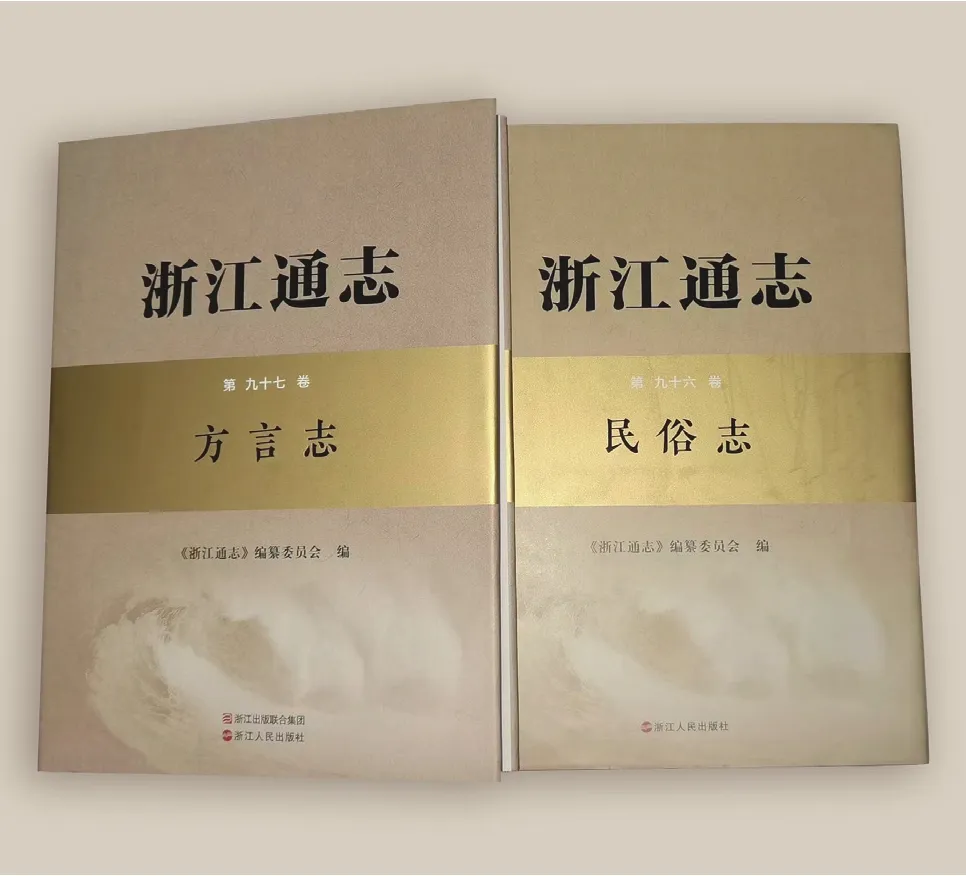
《浙江通志·方言志》和《浙江通志·民俗志》。The two volumes on Zhejiang’s dialects and folk customs in the Zhejiang General Chronicle.
Also, lack of written records required extensive field investigation on folk customs. He Shanmeng, a professor at the School of Philosophy of Zhejiang University and the deputy editor-in-chief of the volume on Zhejiang’s folk customs, said that this is the first time in the history of Zhejiang that folk customs have been included as a separate category. Zhejiang is rich in folk customs, but the research is weak and scattered overall. People often say that “the customs are different just ten miles away”,which shows that the similarities and differences of customs can appear in all administrative regions. But often, the most vivid and down-to-earth traditions in the development of regional history and culture are also folk customs. “We tried to change the perspective to find the expressive power of folk customs in the daily life of ordinary people,” Professor He said. It has taken the Zhejiang Folk Culture Promotion Association eight years to compile the volume.
Zhejiang has a long history, with countless cultural relics and cultural treasures. It is also noticed that among the 113 volumes,there are volumes on the Qiantang River, the Yandang Mountain,the Tianmu Mountain, seawalls, canals, sericulture, tea and the Yue culture, in order to refine and demonstrate the unique natural features and historical context of Zhejiang.
The Qiantang River is the mother river of Zhejiang, and it is also the place to which the Zhejiang people have felt the deepest attachment. Xu Youcheng, the editor-in-chief of the volume on the river, said: “This new edition is not limited to water conservancy,but it highlights the local characteristics of the Qiantang River from the humanistic history.” And the custom of watching the tidal bore began in the Han (202 BC-220 AD) and Wei (220-266)dynasties, flourished in the Tang (618-907) and Song (960-1279)dynasties, and has been passed down to this day. The tide is also a cultural image and spiritual symbol.
Ruan Haogeng, editor-in-chief of volume on Zhejiang’s tea,agrees with this view. The history of tea planting and tea drinking in Zhejiang has gone through thousands of years. There is a lot of space to describe Zhejiang tea culture and strengthen the cultural characteristics of tea. “People cannot do without firewood, rice,oil, salt, sauce, vinegar and tea,” Ruan said. Perhaps it is the humid and rainy climate and light diet in the(south of the Yangtze River) area that made Zhejiang people gradually form the habit of drinking tea, which has evolved into an engrained cultural custom here, and the volume has a special chapter on tea culture,including tea ceremony, tea art, tea house culture, tea etiquette and customs, tea cultural sites, intangible cultural heritage, tea cultural exchanges, tea cultural associations and activities. The poems on tea in the Tang dynasty, tea paintings and calligraphy of the Song dynasty, the tea events in the Yuan dynasty (1206-1368), the tea love in the Ming (1368-1644) and Qing prose and novels, and the songs, dances and films and televisions about tea in modern times,etc., are all recorded one by one. “We also added a section on the 20 existing ancient tea trees in Zhejiang,” Ruan added.
If you visit the Tianmu Mountain Anti-Japanese War Exhibition Hall in Lin’an, Hangzhou, you will find that the captions and stories for the exhibition came from the volume on the Tianmu Mountain, which completely records the changes of Tianmu Mountain in nature, scientific research, ecological protection, tourism development, etc. in various historical periods.In March 2021, the Provincial Local Chronicle Office issued the“Notice on Announcement of Top Ten Typical Cases and Excellent Cases for the Application of”, and the application of the volume on the Tianmu Mountain was selected as one of the Top Ten typical cases. It has also become one of the main reference materials for the construction of Tianmu Mountain Park as a high-quality biodiversity conservation project.
Pan Chengyu, editor-in-chief of the volume on the Yue culture, said comprehensively sorting out the history and culture of the State of Yue (2032-222 BC) is aimed to activate the immortal vitality with the “spirit of courage and sword” at the core, and contribute to the construction of cultural Zhejiang of the new era.“We can’t allow the chronicle to collect dust on the shelf,” Zheng Jinyue, director of the Local Chronicle Office of the Zhejiang Provincial People’s Government, said that Zhejiang will further expand the ways of using the chronicle, so that this old business of more than 2,000 years will see a new leaf.
Digital reform will promote the transformation of traditional local records, and create a batch of local chronicle products that are audible, visible, readable and experienceable. For example, to integrate them into research activities such as Song culture, Grand Canal culture, Qiantang River culture, Poetry Road culture,among others, to give full play to the basic role of the chronicles in the construction of cultural highlands in the new era, and to introduce Zhejiang stories overseas by literary and artistic creations.

天目山一景。龚军勇/摄A glimpse of the Tianmu Mountain. Photo by Gong Junyong.

